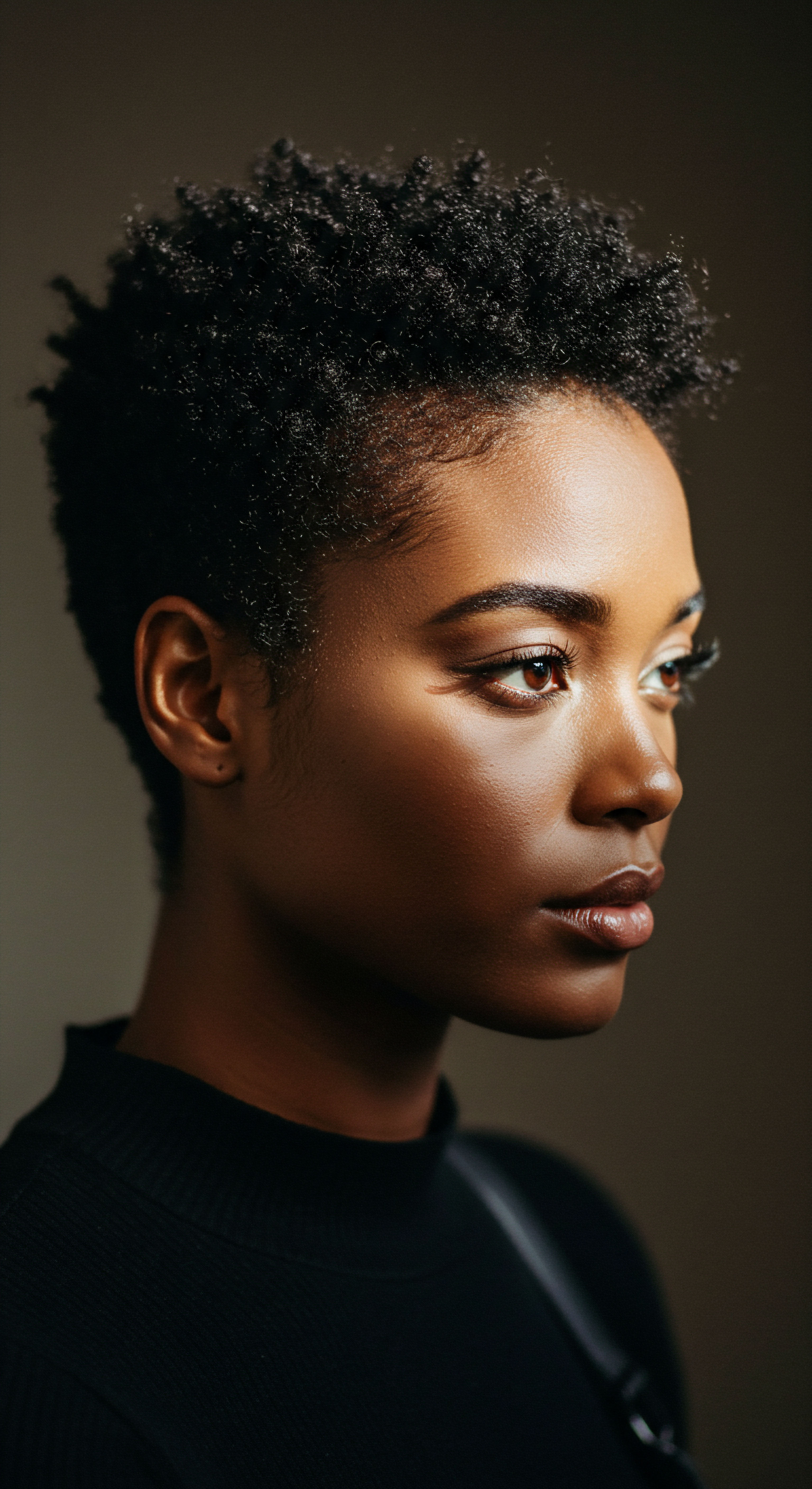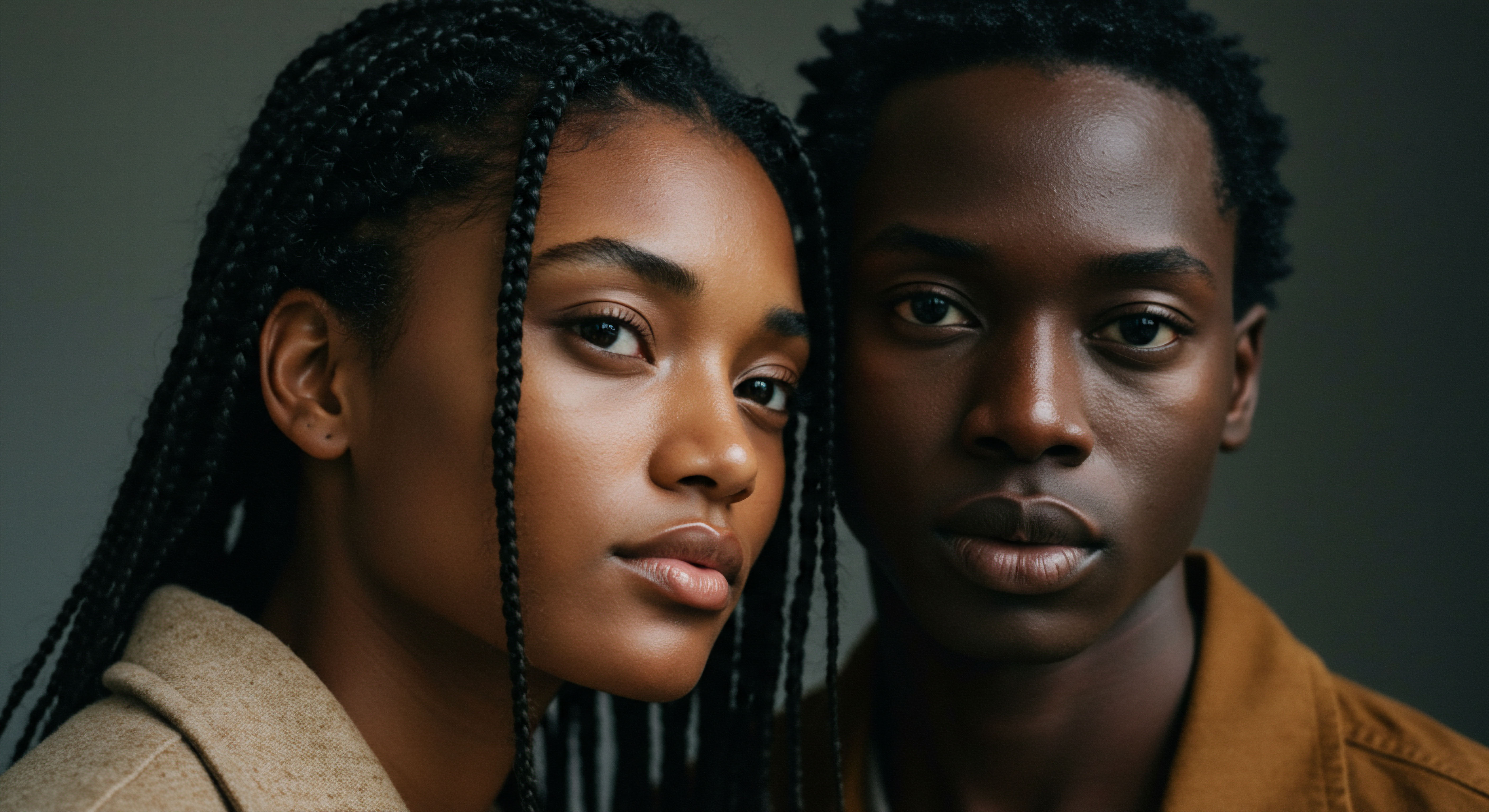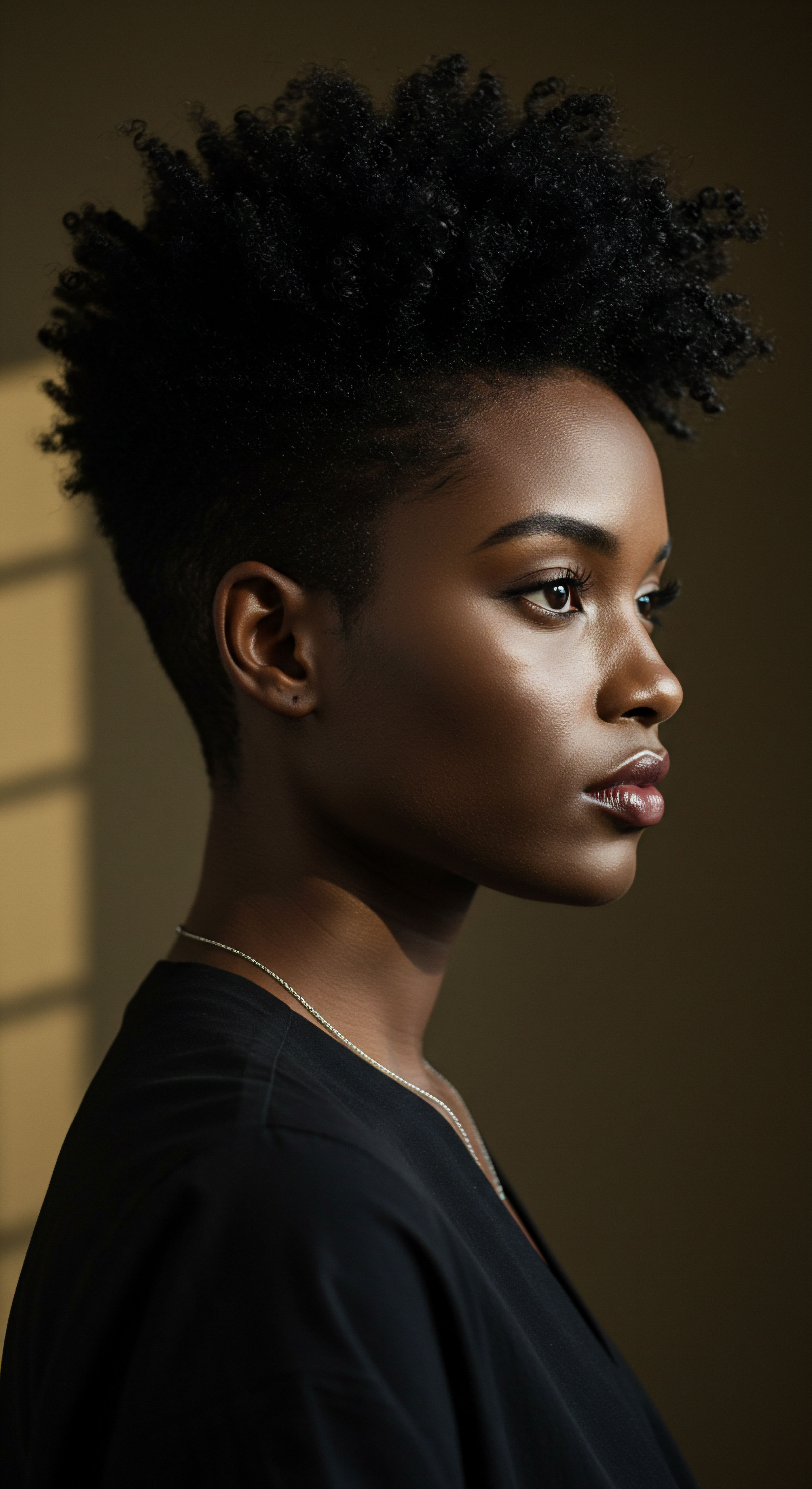
Roots
The very strands that crown us, particularly those with a distinct curl and coil, hold whispers of ancestral wisdom. A quiet inquiry into how these remarkable textures found sustenance and softness in times long past, before bottles lined our shelves, unveils a profound connection to the earth and its offerings. It is a consideration that reaches beyond mere aesthetics, touching upon the very essence of resourcefulness, communal knowledge, and an intimate relationship with nature’s bounty. Our present-day quest for moisture, for the spring and vitality of our coils, finds a compelling echo in the distant echoes of history, revealing that the longing for well-cared-for hair is a timeless human aspiration.

Hair’s Earliest Protectors
Long before the advent of industrial processes, human communities understood the delicate requirements of their hair. For those with coiled strands, the inherent structure presents a unique challenge ❉ the spiral shape means natural scalp oils struggle to descend the hair shaft, leaving the ends particularly susceptible to dryness. This anatomical reality necessitated early, ingenious solutions.
Ancient peoples were keen observers of their environments, recognizing which plants, minerals, and animal products held the key to conditioning and protection. Their methods were often deeply integrated into daily life, reflecting a holistic view of well-being where personal adornment was inseparable from health and cultural expression.
Ancient communities, recognizing the unique needs of coiled hair, ingeniously sourced natural elements for conditioning and protection.
Consider the ingenuity of early African civilizations. Their knowledge of local flora was unparalleled. The Saharan and sub-Saharan regions, despite their arid climates, offered specific botanical treasures. The fruit of the shea tree, for instance, known for centuries across West Africa, yielded a rich, creamy butter.
This substance, rendered from the nut, possesses a complex profile of fatty acids and unsaponifiable components, making it an exceptional emollient. Its application would have created a protective barrier, sealing in the hair’s natural moisture and guarding against environmental stressors like sun and wind. This was not a casual application; it was a ritual, a knowing gesture passed down through generations.

Botanical Offerings for Coiled Strands
Across various ancient cultures, specific plant-derived substances became central to hair care. The choice of these emollients was rarely arbitrary; it stemmed from generations of empirical observation and a deep understanding of their properties.
- Shea Butter ❉ From the African shea tree, a rich, solid fat prized for its intense moisturizing and protective qualities, shielding hair from harsh elements.
- Olive Oil ❉ A staple across the Mediterranean, its fatty acid composition provided softness and shine, often used in conjunction with aromatic herbs.
- Castor Oil ❉ Widely used in ancient Egypt and parts of Africa, known for its viscous consistency and purported ability to coat and strengthen hair.
These were often applied as pure oils or in concoctions with other plant extracts. The consistency and application methods varied. Some were warmed slightly to ease spreading, others were massaged directly into the scalp and hair. The objective was consistently to lubricate the strands, minimize breakage, and impart a healthy sheen.
This rudimentary science, born of necessity and wisdom, laid the groundwork for countless generations of hair care practices. The very act of preparing these botanical elixirs, often a communal activity, wove them into the social fabric of the community.
| Emollient Shea Butter |
| Primary Ancient Region West Africa |
| Reported Benefit for Hair Moisture retention, UV protection |
| Emollient Olive Oil |
| Primary Ancient Region Mediterranean, Middle East |
| Reported Benefit for Hair Softening, shine, scalp conditioning |
| Emollient Castor Oil |
| Primary Ancient Region Egypt, Africa |
| Reported Benefit for Hair Coating, perceived strengthening |
| Emollient Coconut Oil |
| Primary Ancient Region Southeast Asia, Pacific Islands |
| Reported Benefit for Hair Penetration, protein protection |
| Emollient These natural resources provided foundational hair conditioning for diverse ancient peoples. |

Ritual
Stepping from the foundational knowledge of ingredients into the daily and seasonal practices of ancient peoples reveals a profound interplay between resource and application. The query of how coiled hair found its moisture in antiquity is not merely about identifying what was used, but how it was applied, how often, and within what cultural context. These were not isolated acts of vanity; they were integrated segments of life, often laden with meaning, social significance, and a rhythmic connection to the cycles of nature. The deliberate, consistent actions of ancient hands, working with natural substances, speak volumes about their dedication to hair health and presentation.

What Daily Practices Sustained Coiled Hair?
The rhythms of life in ancient societies dictated much of their hair care. For coiled textures, daily or near-daily moisturizing was likely a necessity, especially in arid climates. The goal was to prevent excessive dryness, which leads to tangling and breakage. Rather than a single, heavy application, many ancient practices likely involved lighter, more frequent conditioning.
For instance, in ancient Egypt, while elaborate wigs and extensions were prevalent, the care of natural hair was also important. Evidence from tomb paintings and texts points to the use of various oils and animal fats mixed with fragrant resins. These mixtures, often scented with myrrh, frankincense, or cinnamon, served a dual purpose ❉ conditioning the hair and scalp, and providing a pleasant aroma. The application was likely a careful process, working the emollients into the hair from root to tip, perhaps even braiding or twisting the hair afterwards to further seal in the moisture and protect the strands.
Ancient hair care involved rhythmic, deliberate practices, often integrating natural emollients with cultural meaning.
Beyond Egypt, in many sub-Saharan African societies, the practice of oiling and braiding hair was a communal activity, particularly among women. This wasn’t just about appearance; it was about hair preservation. Braids, twists, and locs served as protective styles, minimizing manipulation and exposure to environmental elements, thereby aiding moisture retention. Before braiding, hair would be generously coated with plant-based butters or oils.
This coating provided a lubricating layer, reducing friction between strands and making the styling process gentler. The consistency of these rituals speaks to a deep, practical understanding of hair’s needs.

Application Techniques and Tools
The application of moisturizing agents was often hands-on, though simple tools might have been employed. Combs made of wood or bone, while primarily for detangling, could also aid in distributing emollients.
Consider the ancient use of heat. While direct heat styling as we know it was absent, gentle warmth could have been applied to facilitate the absorption of oils. For example, some traditions might have warmed oils over a low flame or in the sun before application, allowing the substances to penetrate more readily into the hair shaft. This practice, while seemingly simple, shows an intuitive grasp of how temperature affects viscosity and absorption.
The sheer volume of natural substances available meant a diverse approach. Some ancient communities might have used a single, readily available oil, while others, particularly those engaged in trade, could access a wider array of ingredients. The art was in understanding how each substance behaved and how to best prepare it for optimal hair conditioning.
| Method Direct Hand Application |
| Description Massaging oils/butters into hair and scalp |
| Purpose Lubrication, moisture seal, scalp health |
| Method Warm Oil Treatment |
| Description Gently heating emollients before application |
| Purpose Improved absorption, relaxation |
| Method Protective Styling |
| Description Braiding, twisting, coiling hair after moisturizing |
| Purpose Minimizing manipulation, retaining moisture |
| Method Communal Care |
| Description Shared grooming sessions, often with family/community |
| Purpose Knowledge transfer, social bonding, thoroughness |
| Method Ancient application methods prioritized thorough coverage and long-term hair preservation. |

Relay
Moving beyond the visible practices, a deeper inquiry into how ancient people moisturized coiled hair unearths a sophisticated understanding, one that bridged empirical observation with what we now recognize as basic chemistry and physics. This is where the wisdom of the past truly intersects with contemporary scientific understanding, revealing not just what they did, but a profound sense of why their methods proved effective for textured strands. The seemingly simple acts of applying natural substances held complex implications for hair integrity and moisture balance.

How Did Natural Lipids Interact with Coiled Hair?
The efficacy of ancient moisturizing agents, primarily plant oils and animal fats, rests in their lipid composition. Hair, particularly coiled hair, benefits significantly from the presence of lipids, which can supplement the hair’s natural sebum, often insufficient to coat the entire length of a highly textured strand. These natural lipids act as occlusives, forming a protective film on the hair surface, which slows down transepidermal water loss. They also function as emollients, smoothing the cuticle and reducing friction between hair fibers, thereby decreasing mechanical damage and breakage.
Consider the properties of a substance like shea butter, a cornerstone of West African hair care for millennia. Its chemical profile includes oleic acid, stearic acid, linoleic acid, and palmitic acid. These fatty acids are remarkably similar to the natural lipids found in human sebum.
When applied to hair, these lipids can integrate with the hair’s own lipid layer, enhancing its barrier function. This biological compatibility is a significant factor in its effectiveness, allowing for a gentle yet powerful moisturizing action that synthetic alternatives often struggle to replicate without introducing other chemical burdens.
Ancient emollients, rich in natural lipids, provided a protective barrier for coiled hair, mirroring modern scientific understanding of hair’s needs.
A fascinating aspect of ancient practices lies in their unintentional foresight regarding hair protein. Hair is primarily composed of keratin, a protein. Coiled hair, due to its helical structure, can be more prone to cuticle lifting and protein loss. Certain oils, particularly those with a molecular structure small enough to penetrate the hair shaft, such as coconut oil (though less common in ancient African contexts, its principles apply to other penetrating oils), could potentially mitigate this.
Research indicates that coconut oil, for instance, can reduce protein loss for both damaged and undamaged hair when used as a pre-wash or post-wash conditioner. While ancient peoples lacked microscopes to observe this, their consistent use of lipid-rich materials suggests an empirical understanding of their hair’s need for both surface protection and internal fortification. The very act of saturating hair with these oils before activities that might cause damage, such as vigorous washing or styling, speaks to an intuitive protective strategy.

The Role of Humectants and Conditioners
Beyond pure oils, ancient peoples also incorporated substances that functioned as humectants and natural conditioners. Humectants draw moisture from the air into the hair, while conditioners smooth the cuticle and impart softness.
For example, certain plant mucilages, derived from plants like aloe vera or okra, would have provided a slippery, conditioning effect. These substances are rich in polysaccharides, which can form a film on the hair, providing both slip for detangling and a degree of moisture retention. The application of these plant gels, often mixed with oils or water, would have offered a multi-layered approach to hydration, addressing both the external smoothing and internal moisture needs of coiled hair.
The interplay of ingredients was key. A common practice might involve applying a water-based botanical extract first, allowing the hair to absorb some moisture, followed by a heavier oil or butter to seal that moisture in. This layering technique, often rediscovered and lauded in modern natural hair care, was a staple of ancient wisdom.
It demonstrates a practical understanding of how to achieve and maintain moisture balance, even without a formal scientific lexicon. The consistency of application, often coupled with protective styling like braiding or twisting, further reinforced these moisturizing benefits by minimizing manipulation and environmental exposure.
| Ancient Principle Lipid Application |
| Description Using plant oils/butters to coat hair |
| Modern Scientific Analogue Occlusives, emollients, lipid barrier enhancement |
| Ancient Principle Protective Styling |
| Description Braiding, twisting, coiling hair |
| Modern Scientific Analogue Minimizing mechanical stress, moisture retention |
| Ancient Principle Botanical Extracts |
| Description Using plant mucilages (e.g. aloe) |
| Modern Scientific Analogue Humectants, conditioning agents |
| Ancient Principle Layering |
| Description Applying water-based then oil-based substances |
| Modern Scientific Analogue LOC/LCO method (Liquid, Oil, Cream) |
| Ancient Principle Ancient hair care practices align with contemporary understanding of hair science. |

Reflection
The echoes of ancient hair care rituals resonate deeply within our contemporary understanding of coiled strands. What emerges from this consideration is a powerful reaffirmation ❉ the quest for vibrant, well-nourished hair is a timeless pursuit, one that has consistently drawn upon ingenuity, observation, and the gifts of the natural world. The sophisticated simplicity of ancient methods, often relying on locally sourced botanical treasures and intuitive application techniques, stands as a testament to humanity’s enduring connection with its environment and its own bodily needs.
We find ourselves, centuries later, still seeking that delicate balance of moisture, protection, and vitality for our hair, often returning to the very principles our ancestors mastered through lived experience. The wisdom of their hands, guided by the sun, the soil, and the rhythm of their days, continues to whisper lessons of profound care for the crowns we wear.

References
- Rele, J. S. & Mohile, R. B. (2003). Effect of mineral oil, sunflower oil, and coconut oil on prevention of hair damage. Journal of Cosmetic Science, 54(2), 175-192.
- Chung, Y. J. & Chung, Y. S. (2007). Hair Cosmetics ❉ An Overview. Clinics in Dermatology, 25(4), 369-376.
- Robbins, C. R. (2012). Chemical and Physical Behavior of Human Hair. Springer Science & Business Media.
- Salloum, M. (2013). Traditional Beauty Secrets ❉ The Essential Guide to Natural Beauty. Tuttle Publishing.
- Groom, N. (1997). The Perfume Handbook. Blackie Academic & Professional.
- Balsam, M. S. & Sagarin, E. (Eds.). (1972). Cosmetics ❉ Science and Technology. John Wiley & Sons.
- Wondimu, A. & Tekle, Y. (2018). Ethnobotanical study of medicinal plants used for human hair care in selected districts of Wolayita Zone, Southern Ethiopia. Journal of Ethnopharmacology, 213, 276-285.